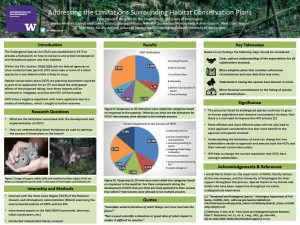Addressing the Limitations Surrounding Habitat Conservation Plans
Environmental policy dictates the measures taken to balance environmental protection and conservation with projects and resource consumption. Policies like the Endangered Species Act (ESA) are meant to protect and mitigate the harm done to endangered and threatened species. However, there are times when a project’s impact to these species cannot be fully mitigated. In this case, these applicants (non-federal parties) must apply for an incidental take permit (ITP) by developing a Habitat Conservation Plan (HCP). These plans have developed a negative reputation amongst applicants due to the inordinate amount of time and money required. Furthermore, these plans are fluttered with limitations that prevent the best conservation and management plans. During my time interning at the National Oceanic and Atmospheric Administration West Coast Region, I evaluated the documentation processes described under NEPA and Section 10(a)(1)(B) of the ESA (Habitat Conservation Plans) for potential functional equivalence. This is the idea of streamlining processes to become more efficient for both the applicant and federal agency. As a result, I developed a background concerning the HCP process and decided to further examine its limitations. To accomplish this, I conducted a deep literature review, looked at finalized plans, and conducted interviews with 20 relevant experts in the field. With this information I found a multitude of limitations ranging from: funding concerns, lengthy development time, insufficient data, and more. Being able to identify these components provides a foundation to revitalize the HCP program; making it more consistent and helping to optimize the conservation efforts to species.
